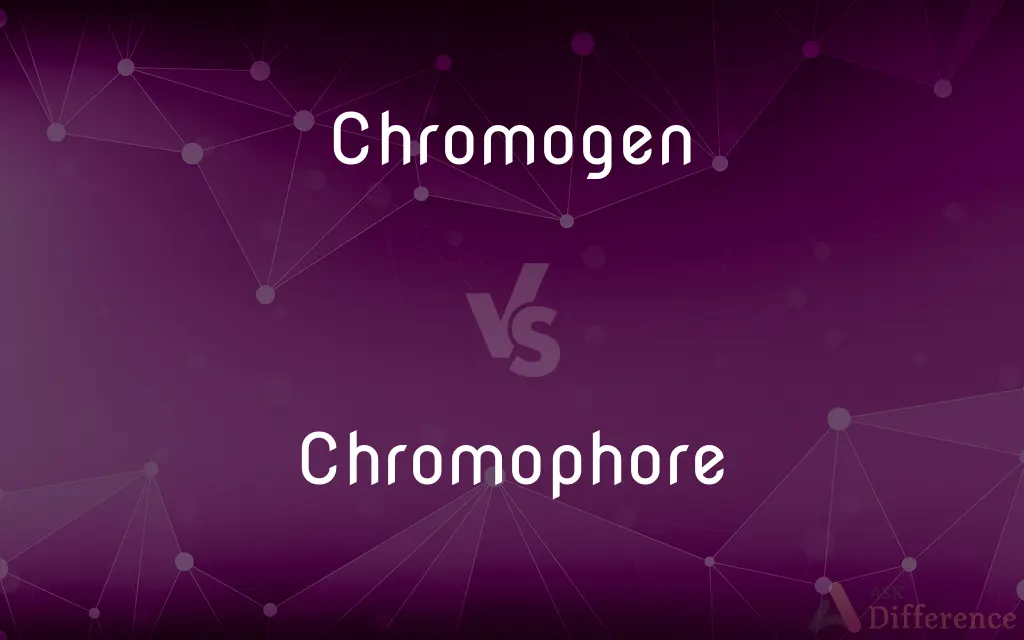Chromogen vs. Chromophore — What's the Difference?
By Maham Liaqat & Fiza Rafique — Updated on March 29, 2024
A chromogen is a colorless compound that becomes colored upon undergoing a chemical reaction, while a chromophore is part of a molecule responsible for its color, absorbing specific wavelengths of light.

Difference Between Chromogen and Chromophore
Table of Contents
ADVERTISEMENT
Key Differences
Chromogens play a crucial role in various chemical and biological staining processes, where they react to form colored compounds, making them essential in fields like histology and microbiology for visualizing cellular components. On the other hand, chromophores are the parts of molecules that give them their color by absorbing certain wavelengths of light and reflecting others.
Chromogens are often utilized in conjunction with specific reagents or under certain conditions to produce a visible reaction, highlighting the presence of specific molecules or chemical groups within a sample. Chromophores, in contrast, are intrinsic to the structure of colored molecules and do not require a chemical reaction to display color.
The concept of a chromogen is particularly relevant in the context of staining techniques, where the goal is to create contrast within samples by chemically inducing coloration. Chromophores, however, are studied to understand and manipulate the color properties of materials, playing a significant role in the development of dyes, pigments, and optical devices.
Chromogens are valuable in diagnostic assays and research, where they enable the detection and visualization of various biological and chemical entities. Chromophores are integral to the fields of materials science, photophysics, and organic chemistry, among others, where understanding and manipulating the interaction of molecules with light is crucial.
Despite their differences, both chromogens and chromophores are essential to scientific research and technological development, with their respective roles in coloring compounds and determining the color of materials being fundamental to a wide range of applications. The study and manipulation of these entities contribute to advances in medical diagnostics, material design, and our understanding of light-matter interactions.
ADVERTISEMENT
Comparison Chart
Definition
A colorless compound that becomes colored upon a chemical reaction.
Part of a molecule responsible for its color, absorbing specific wavelengths of light.
Role
Induces coloration in various staining processes.
Determines the color of substances by absorbing and reflecting light.
Application
Essential in histology, microbiology, and chemical analysis for visualization.
Crucial in materials science, photophysics, and the development of dyes and pigments.
Requirement for Color
Requires a chemical reaction to display color.
Inherent color properties, does not require a reaction to be visible.
Importance
Enables the detection and differentiation of microscopic structures and molecules.
Fundamental to the science of colorimetry and the design of materials with desired optical characteristics.
Compare with Definitions
Chromogen
Essential for visualizing cellular components.
Chromogens are used to distinguish between different types of tissue.
Chromophore
Absorbs specific light wavelengths.
The presence of a chromophore determines the color of a dye.
Chromogen
Used in diagnostic assays.
Chromogens facilitate the observation of antigens in immunoassays.
Chromophore
Molecular group responsible for color.
The chromophore within chlorophyll absorbs red and blue light, making plants appear green.
Chromogen
A substance that develops color upon reacting.
In histological staining, the chromogen reacts to form a visible pigment.
Chromophore
Found in colored compounds.
Natural pigments have chromophores that reflect certain wavelengths.
Chromogen
Integral to staining techniques.
Specific chromogens are selected based on their reaction to cellular constituents.
Chromophore
Key in material coloration.
Synthetic fibers are treated with chromophores to achieve vibrant colors.
Chromogen
Reacts to become colored.
The addition of a developer causes the chromogen to produce a color.
Chromophore
Influences material design.
Chromophores are engineered into plastics to create desired optical properties.
Chromogen
The term chromogen is applied in chemistry to a colourless (or weakly coloured) chemical compound that can be converted by chemical reaction into a compound which can be described as "coloured". There is no universally agreed definition of the term.
Chromophore
A chromophore is the part of a molecule responsible for its color. The color that is seen by our eyes is the one not absorbed by the reflecting object within a certain wavelength spectrum of visible light.
Chromogen
A substance which can be readily converted into a dye or other coloured compound.
Chromophore
Any of various chemical groups that absorb light of certain wavelengths and when present in an organic compound, such as a dye or pigment, are responsible for the color of the compound.
Chromogen
(Chemistry) A substance capable of conversion into a pigment or dye.
Chromophore
(chemistry) that part of the molecule of a dye responsible for its colour
Chromogen
(Biology) A strongly pigmented or pigment-generating organelle, organ, or microorganism.
Chromophore
(chemistry) (more generally) the group of atoms in a molecule in which the electronic transition responsible for a given spectral band is located
Chromogen
(chemistry) Any substance that lacks colour, but can be converted into a pigment or dye.
Chromophore
Any chemical group or residue (as NO2; N2; or O2) which imparts some decided color to the compound of which it is an ingredient.
Chromogen
(biology) A strongly pigmented organelle or organism.
Chromophore
The chemical group that gives color to a molecule
Chromogen
Vegetable coloring matter other than green; chromule.
Chromogen
Any colored compound, supposed to contain one or more chromophores.
Chromogen
A compound that can be converted to a pigment
Common Curiosities
Can chromogens and chromophores be found in the same substance?
Yes, a substance can contain chromogens that react to form colored compounds, which then exhibit color through their chromophores.
What is a chromogen?
A chromogen is a compound that becomes colored when it undergoes a specific chemical reaction.
Is the color change in chromogens reversible?
The color change in chromogens is typically not reversible, as it involves a chemical reaction that alters the compound’s structure.
How do chromogens work?
Chromogens react chemically to develop color, making them crucial in staining processes for visualization purposes.
What is a chromophore?
A chromophore is a part of a molecule responsible for its color, due to its ability to absorb certain wavelengths of light.
How do chromogens contribute to medical diagnostics?
In diagnostics, chromogens enable the visualization of cells, tissues, or substances by producing color reactions that highlight specific components.
Why are chromophores important?
Chromophores determine the color of materials by absorbing and reflecting specific light wavelengths, influencing their appearance and applications.
What role do chromophores play in material science?
Chromophores are critical in designing materials with specific optical properties, including dyes, pigments, and colored plastics.
What are some applications of chromophores?
Applications include dye and pigment creation, development of optical devices, and design of materials with specific coloration and light-absorption properties.
How does light interact with chromophores?
Light interacts with chromophores through absorption of certain wavelengths, which determines the color that the material reflects and thus appears to the human eye.
Share Your Discovery

Previous Comparison
Insanity vs. Madness
Next Comparison
Street vs. PathwayAuthor Spotlight
Written by
Maham LiaqatCo-written by
Fiza RafiqueFiza Rafique is a skilled content writer at AskDifference.com, where she meticulously refines and enhances written pieces. Drawing from her vast editorial expertise, Fiza ensures clarity, accuracy, and precision in every article. Passionate about language, she continually seeks to elevate the quality of content for readers worldwide.














































